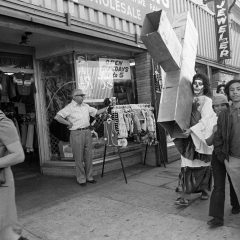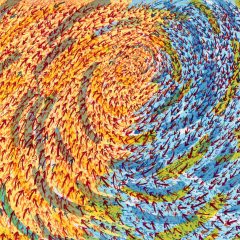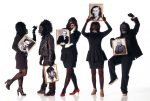Carolee Schneemann is one of the most important artists of the past forty years, so why did I find myself on a bus headed to a rural university an hour and a half north of New York City to see the most complete American overview of her work since an exhibition at the New Museum in 1997? Performance art is unthinkable without Schneemann who developed a feminist-centered art before the feminist movement existed. She was early in working across media and creating installations, and a retrospective of her extensive work in video traveled to major museums in Europe and the U.S. And she is still working. Her art embodies that term one finds in art department course listings: new forms. It seems that the departments of contemporary art in our major museums aren’t ready for her yet.
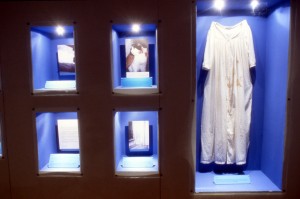
The exhibition Carolee Schneemann; Within and beyond the premises, was organized by Brian Wallace (formerly at Moore College of Art) for the Samuel Dorsky Museum of Art at SUNY, New Paltz where ran Feb. 6 – July 25, 2010. More than seventy works were installed around the themes of research, ecstasy, furies and dwelling; although the themes could just have easily been love, anger, joy and humor. At the entrance was a vitrine holding objects, the most arresting of which was a nightgown with blood-stains; not evidence of violence as in Lucia de Lammermoor, but of the final illness of a beloved cat, Vesper. Vesper’s Pool (2002) consists of the collection of objects, photographs and a video which record some of the cat’s favorite places and things and Schneemann’s care-giving at the end of his life. It includes photos of Vesper’s morning ritual of waking Schneemann with a kiss. Some objected to what they saw as erotic relations with an animal; have they never stroked the family pet? The work is about love and mourning, the artist’s understanding that our minds and bodies are inseparable from each other and from the larger natural world, all of which is defined ultimately by death. As with much of her work it reflects Schneemann’s spirituality, a deeply un-fashionable subject for art in the late 20th Century.
Schneemann’s art has always addressed major themes and she generates it with the aid of drawings, notebooks, photographs, dream imagery and research that usually extends over a substantial period of time. The exhibition included examples of studies, finished pieces and various performance artifacts and photographs that became part of later objects and/or installations. She has exhibited some of the videos both as single channel and as part of more complex pieces. The exhibition began with Schneemann’s earliest work, tracing her development from expressionistic painting to multi-media work akin to Rauschenberg’s Combines to the performances for which she is best known and her complex installations.
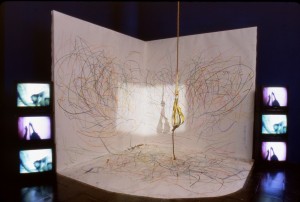
‘Up To and Including Her Limits’ (1973-76) was a performance in which the artist, suspended from a harness, drew on the walls and floor surrounding her, reaching as far as she could as she swung through the space. She turned the performance setting into an installation consisting of the suspended harness and surrounding, marked walls flanked by six monitors showing the performance, with a film projector creating a spotlight on the artist’s absence. While the exhibition situated the installation in terms of Schneemann’s ecstatic movement it also pointed to the interaction of freedom and restraints.
The video, Precarious (2009) included footage of the artist dancing blindfolded, as well as vintage film of a bear which has been taught to dance on a leash and a clip of Snowbell, the cockatoo that showed the world that animals, too, have rhythm. The cross-species view again, and Schneemann’s well-known use of the body; we are our bodies was a repeated theme. That declaration and Schneemann’s employment of her own body and of bodily-centered knowledge was inherent to her feminist agency from the 60s on and it made some women uncomfortable. She wasn’t angry at men, though she was certainly angry about some of the things that some men did and said. Or didn’t say.
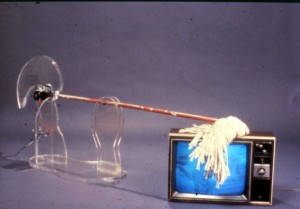
Schneemann’s anger is behind Snows (1966), done in reaction to the war in Vietnam. It was the ultimate gesamtkunstwerk, merging performers, film, light and sound, some of which was generated in response to the audience (Snows was represented in the exhibition with drawings, a film transferred to video and collages of performance photographs). War Mop (1983) , a later piece about war, consisted of a television monitor showing imagery of bomb damage of Beirut and a mop which loudly and repeatedly slapped against it via a mechanical system. These ineffectual (and feminine?) attempts to clean up behind war’s damage to civilian lives could be heard throughout the exhibition.
Among the unfamiliar works were several wonderful drawings for a room-sized structure, Parts of a Body, which was intended to be climbed on and walked through, rather like the heart model at the Franklin Institute, but with less clear didactic intent. There were also very funny photographs, take-offs on America’s endless cult of self-improvement, titled Agression for Couples and Exercise for Couples (1972).
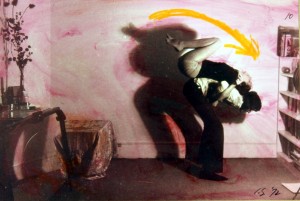
I had seen a fair number of the works previously, but always one by one. Seeing Schneemann’s career laid out in all its conceptual and material variety, complexity and depth made me grateful that a small museum in a rural university had the wisdom to bring it together. Schneemann’s name is in the art history books but her career has not been given anything like the attention it deserves. I am also grateful that the artist has been willing to trust her own vision.


